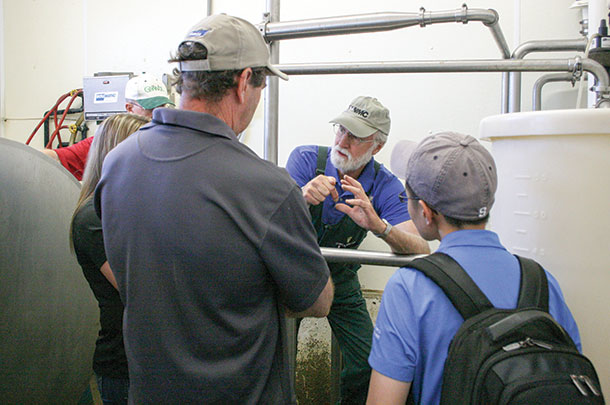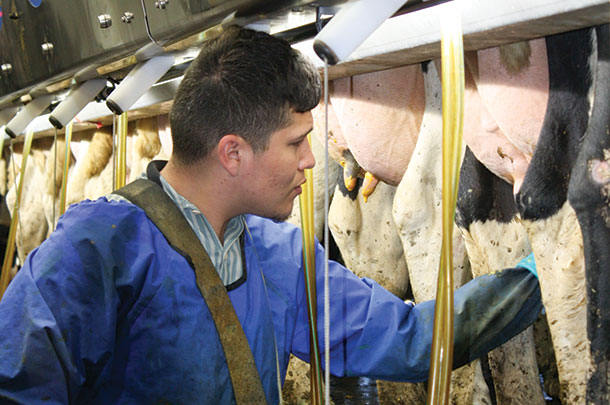The 2016 National Mastitis Council (NMC) Regional Meeting was held June 29-30 in Appleton, Wisconsin. Nearly 200 milk quality professionals attended the event, along with three Wisconsin-based Progressive Dairyman editors.
Check out their highlights from the meeting.
Short courses
Eight specialized short courses were offered on Day 1 to allow attendees an in-depth look at topics such as milking systems, on-farm culturing and milk quality, employee training, analyzing records and designing barns. Progressive Dairyman had the opportunity to attend two of the courses.
The first session was held on a local dairy farm where participants were split into two groups to analyze milk quality from the back of the barn to the front of the parlor.
 David Reid, Rocky Ridge Dairy Consulting LLC, Hazel Green, Wisconsin; and Brandon Treichler, Select Milk Producers, Canyon, Texas; led the groups through the farm from the freestall and holding areas to the main parlor and special-needs parlor. After conducting the walk-through, the two groups met to discuss and determine three key recommendations for the farm owner.
David Reid, Rocky Ridge Dairy Consulting LLC, Hazel Green, Wisconsin; and Brandon Treichler, Select Milk Producers, Canyon, Texas; led the groups through the farm from the freestall and holding areas to the main parlor and special-needs parlor. After conducting the walk-through, the two groups met to discuss and determine three key recommendations for the farm owner.
The afternoon session, led by Doug Reinemann, University of Wisconsin – Madison, focused on the need for gentle milking to preserve excellent teat condition. His three aspects of gentle milking were maintaining the right amount of keratin in the teat canal, preventing teat tissue congestion and preserving the integrity of teat skin.
Visual inspection of the cows’ teats can aid in diagnosis issues with liner performance and milking system settings.
—PD Editor Karen Lee
Farm tours
Attendees spent a day learning firsthand how three Wisconsin dairies manage mastitis to achieve excellent milk quality. Dan Brick, owner of Brickstead Dairy, explained how he worked closely with a veterinarian to cut the average somatic cell count (SCC) of his 900-cow herd down to under 100,000.
Milk quality meetings are held weekly to evaluate cultures, check milking equipment function and review charts showing chronic and new infection rates among the herd. “Good, clean teat ends” are what he strives for, and a double-dipping protocol (dip, strip, dip) helps to achieve that.
Shiloh Dairy serves as a shining example of how quality milk comes from healthy cows. “We want to milk the best 2,100 cows we can,” Cathy Speirs said. Along with her husband, Gordon, and sons Travis and Tyler, the Speirses are dedicated to cleanliness every step of the way, from the maternity pens and calf facilities all the way to the stall beds.
In the parlor, teat-scrubbing brushes are a tool that has helped their milking crew maintain a consistent cleaning routine.
The group also heard from Jackie Schnackel, herd manager at Schmidt’s Grand View Dairy, who maintains a somatic cell count around 80,000 with a 1,200-cow herd bedded with dried manure solids. She keeps mastitis to a minimum by focusing on cow comfort, employee training and aggressively finding and treating infections.
—PD Editor Peggy Coffeen
Speaker sessions
Day 2 of the meeting focused on people and processes designed to optimize animal health and milk quality while meeting public concerns related to antibiotic residues and resistance. Here were a few of the topics covered.
Antibiotic use and public perceptions
Even though the numbers show otherwise, the power of general and social media is convincing consumers there are greater risks related to antibiotic residues in milk, noted Pam Ruegg, University of Wisconsin – Madison milk quality specialist. That perception is leading to greater scrutiny and regulation of antimicrobial use on dairy farms.
Ruegg said on-farm animal health and milk quality teams must ensure all uses of antibiotics are justified and will result in improved cow welfare. Farms should have appropriate management structures to limit the number of people who are allowed to treat animals, and veterinarians should be consulted for development and monitoring of treatment protocols.
Selective vs. blanket dry cow therapy
The practice of infusing all quarters of all cows (blanket treatment) with a long-acting microbial at the time of dry-off has been a standard dairy herd practice for decades, curing intramammary infections (IMI) present at dry-off and preventing new IMI early in the dry period.
As industry-wide bulk tank somatic cell counts improve, and scrutiny into antimicrobial use on dairy farms increases, selective dry cow therapy might be an alternative management practice, according to Sandra Godden, a professor in the University of Minnesota College of Veterinary Medicine.
Godden and a University of Minnesota team conducted a pilot program using selective therapy, which involves assessing IMI status of each cow or quarter. Only cows thought to be infected would receive intramammary antibiotic therapy.
Make proper culling decisions
Katie Mrdutt, outreach specialist for the Wisconsin Medical Association’s Food Armor program, described how the non-regulatory initiative is resulting in improved food safety by reducing drug residues in culled dairy cows.
The program requires herd owners and managers to work with their veterinarians to establish protocols, standard operating procedures and record-keeping systems to improve on-farm drug management.
 Participants focus on earlier decisions to treat (or not treat) animals with antibiotics, paying attention to both milk and meat withdrawal periods when drugs are used either according to label or extra-label, managing cow health and body condition prior to transporting her to slaughter and making the decision for on-farm euthanasia rather than using the auction barn as a dumping ground for problem animals.
Participants focus on earlier decisions to treat (or not treat) animals with antibiotics, paying attention to both milk and meat withdrawal periods when drugs are used either according to label or extra-label, managing cow health and body condition prior to transporting her to slaughter and making the decision for on-farm euthanasia rather than using the auction barn as a dumping ground for problem animals.
People, strategy and execution
Jack Harkins, Harkins Leadership Development Corporation, Portage, Wisconsin, provided common attributes of leadership among winning teams, whether on the football field or on a dairy farm.
Three key components of any team are its people, strategy and execution. From Harkins’ perspective, too many teams focus on execution, especially when things go wrong.
“Anyone in position of leadership or influence must remember to dance between all three of these. But, be careful of the execution trap,” Harkins said. “Much of your success will depend on your ability to attract and retain quality people. The more time you spend with people, the less time you have to spend on execution.” PD
—PD Editor Dave Natzke
PHOTO 1: Around 20 attendees from the NMC regional meeting visited three dairies to learn about on-farm mastitis management. They are pictured here at Shiloh Dairy.
PHOTO 2: David Reid, Rocky Ridge Dairy Consulting LLC, led a walk-through of a local dairy farm. He discussed what to look for in evaluating milking equipment when the group stopped outside the farm’s older special-needs parlor. RIGHT: Around 20 attendees from the NMC regional meeting visited three dairies to learn about on-farm mastitis management. They are pictured here at Shiloh Dairy.
PHOTO 3: Brickstead Dairy recently installed an LED light in the milking parlor, which helps milkers better see what they are doing and ensure proper teat cleaning. Photos by PD Editors Peggy Coffeen and Karen Lee.



